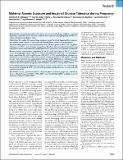| dc.contributor.author | Ettinger, Adrienne S | |
| dc.contributor.author | Zota, Ami R. | |
| dc.contributor.author | Amarasiriwardena, Chitra J. | |
| dc.contributor.author | Hopkins, Marianne | |
| dc.contributor.author | Schwartz, Joel David | |
| dc.contributor.author | Hu, Howard | |
| dc.contributor.author | Wright, Robert O. | |
| dc.date.accessioned | 2011-05-11T03:15:48Z | |
| dc.date.issued | 2009 | |
| dc.identifier.citation | Ettinger, Adrienne S., Ami R. Zota, Chitra J. Amarasiriwardena, Marianne R. Hopkins, Joel Schwartz, Howard Hu, and Robert O. Wright. 2009. Maternal arsenic exposure and impaired glucose tolerance during pregnancy. Environmental Health Perspectives 117(7): 1059-1064. | en_US |
| dc.identifier.issn | 0091-6765 | en_US |
| dc.identifier.uri | http://nrs.harvard.edu/urn-3:HUL.InstRepos:4887126 | |
| dc.description.abstract | Background: Accumulating evidence has shown an increased risk of type 2 diabetes in general populations exposed to arsenic, but little is known about exposures during pregnancy and the association with gestational diabetes (GD). Objectives: We studied 532 women living proximate to the Tar Creek Superfund Site to investigate whether arsenic exposure is associated with impaired glucose tolerance during pregnancy. Methods: Blood glucose was measured between 24 and 28 weeks gestation after a 1-hr oral glucose tolerance test (GTT) as part of routine prenatal care. Blood and hair were collected at delivery and analyzed for arsenic using inductively coupled plasma mass spectrometry with dynamic reaction cell. Results: Arsenic concentrations ranged from 0.2 to 24.1 μg/L (ppb) (mean ± SD, 1.7 ±1.5) and 1.1 to 724.4 ng/g (ppb) (mean ± SD, 27.4 ± 61.6) in blood and hair, respectively. One-hour glucose levels ranged from 40 to 284 mg/dL (mean ± SD, 108.7 ± 29.5); impaired glucose tolerance was observed in 11.9% of women when using standard screening criterion (> 140 mg/dL). Adjusting for age, Native-American race, prepregnancy body mass index, Medicaid use, and marital status, women in the highest quartile of blood arsenic exposure had 2.8 higher odds of impaired GTT than women in the lowest quartile of exposure (95% confidence interval, 1.1–6.9) (p-trend = 0.008). Conclusions: Among this population of pregnant women, arsenic exposure was associated with increased risk of impaired GTT at 24–28 weeks gestation and therefore may be associated with increased risk of GD. | en_US |
| dc.language.iso | en_US | en_US |
| dc.publisher | National Institute of Environmental Health Sciences | en_US |
| dc.relation.isversionof | doi:10.1289/ehp0800533 | en_US |
| dc.relation.hasversion | http://www.ncbi.nlm.nih.gov/pmc/articles/PMC2717130/pdf/ | en_US |
| dash.license | LAA | |
| dc.subject | arsenic | en_US |
| dc.subject | gestational diabetes | en_US |
| dc.subject | impaired glucose tolerance | en_US |
| dc.subject | pregnancy | en_US |
| dc.subject | Superfund | en_US |
| dc.title | Maternal arsenic exposure and impaired glucose tolerance during pregnancy | en_US |
| dc.type | Journal Article | en_US |
| dc.description.version | Version of Record | en_US |
| dc.relation.journal | Environmental Health Perspectives | en_US |
| dash.depositing.author | Ettinger, Adrienne S | |
| dc.date.available | 2011-05-11T03:15:48Z | |
| dash.affiliation.other | HMS^Medicine-Brigham and Women's Hospital | en_US |
| dash.affiliation.other | SPH^Exposure Epidemiology and Risk Program | en_US |
| dash.affiliation.other | HMS^Medicine-Brigham and Women's Hospital | en_US |
| dash.affiliation.other | HMS^Medicine-Brigham and Women's Hospital | en_US |
| dash.affiliation.other | SPH^Exposure Epidemiology and Risk Program | en_US |
| dash.affiliation.other | HMS^Medicine-Brigham and Women's Hospital | en_US |
| dash.affiliation.other | SPH^Environmental+Occupational Medicine+Epi | en_US |
| dash.affiliation.other | HMS^Pediatrics-Children's Hospital | en_US |
| dc.identifier.doi | 10.1289/ehp0800533 | * |
| dash.contributor.affiliated | Hopkins, Marianne | |
| dash.contributor.affiliated | Ettinger, Adrienne | |
| dash.contributor.affiliated | Wright, Robert | |
| dash.contributor.affiliated | Amarasiriwardena, Chitra | |
| dash.contributor.affiliated | Schwartz, Joel | |
| dc.identifier.orcid | 0000-0002-2557-150X | |


